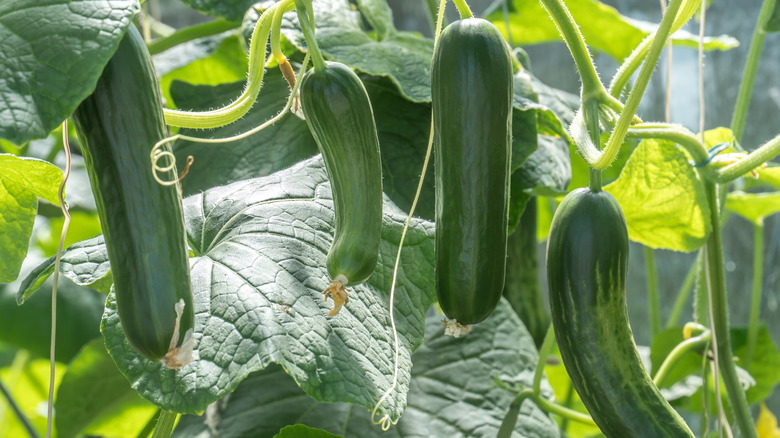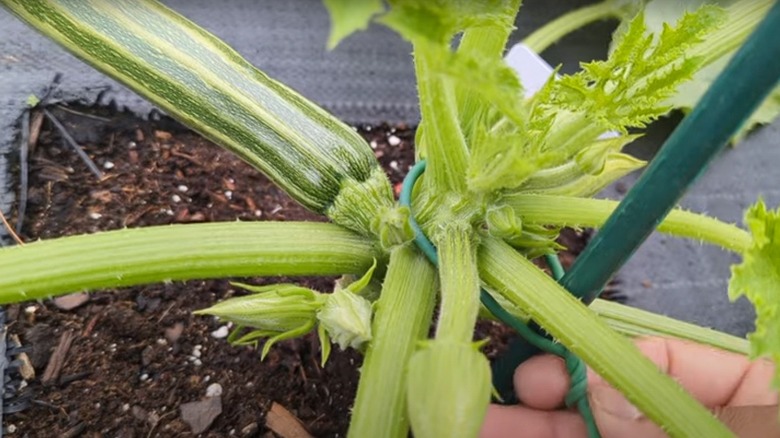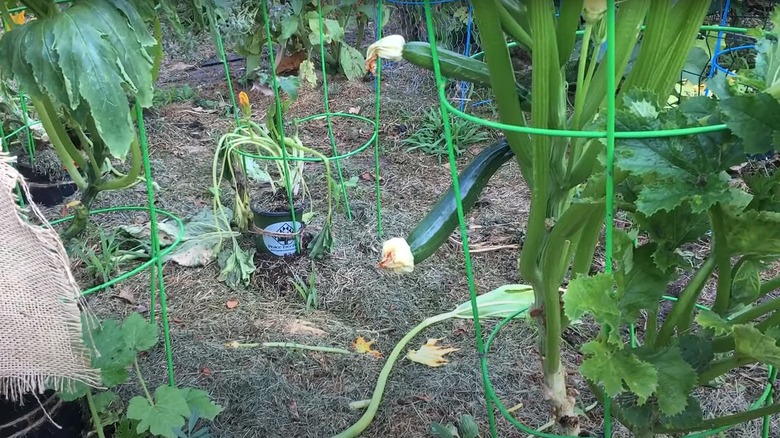Here's Why You Should Be Growing Zucchini Vertically
It's time to go vertical and take your zucchini game to new heights. Why settle for the same old sprawling mess in your garden when you can reach for the sky with your veggies? Growing zucchini vertically is all the rage, and not just because it looks cool — it's actually super practical too. Zucchini, with its vibrant green color and versatile culinary uses, is a popular vegetable among gardeners and home cooks alike. It's not only delicious but also incredibly easy to grow, making it an excellent addition to any vegetable garden. While most people grow zucchini in traditional horizontal beds, there's a growing trend towards vertical gardening, especially for space-constrained gardens or urban environments.
Growing zucchini vertically offers several advantages that make it a compelling choice for both seasoned gardeners and beginners. By adopting this method, you can maximize space efficiency, particularly in small gardens or urban settings where ground space is limited. Vertical gardening allows you to expand your growing area without compromising on the quantity or quality of your zucchini harvest. Additionally, growing zucchini vertically improves air circulation and sunlight exposure, reducing the risk of diseases and promoting healthier plant growth. So, whether you have a small balcony or a spacious backyard, consider giving vertical zucchini gardening a try and enjoy the benefits it offers.
Maximizing space, curb appeal, and efficiency
Why settle for limited ground space when you can tower over the competition with your veggies? Growing zucchini vertically not only saves valuable garden real estate but also provides your plants a chance to show off their climbing skills. Vertical gardening is the secret weapon for space-strapped gardeners and urban dwellers. Say goodbye to crowded garden beds and hello to a sky-high jungle of zucchinis. With some trellises, stakes, or even repurposed household items, you can guide those zucchini vines upward, creating a green masterpiece that defies gravity.
Moreover, verticality adds a captivating visual element to any garden. Zucchini can transform a plain wall or fence into a vibrant green tapestry, creating a living work of art. Vertical gardening also offers opportunities for creative and unique designs, allowing you to showcase your plants in an aesthetically pleasing way. Whether you prefer a lush, cascading display or a structured and organized arrangement, vertical gardening allows you to unleash your creativity and enhance the overall beauty of your garden or outdoor space.
Furthermore, vertical gardens offer convenience when it comes to maintenance and harvesting. With plants growing upward, it becomes easier to access and care for them. Tasks such as watering, fertilizing, pruning, and inspecting for pests or diseases are more accessible and less physically demanding. Additionally, harvesting becomes more convenient as the produce is elevated and within reach, eliminating the need to bend down or search through dense foliage within the garden bed.
Improved air circulation and sunlight exposure
Hey, sunshine! That's right, growing zucchini vertically isn't just about space — it's also about giving your plants the VIP treatment when it comes to sunlight exposure. Typically, zucchinis grow along the ground, taking up large amounts of garden bed space and shielding any other plants from the sun with their large leaves. At the same time, when zucchinis grow horizontally, the lower leaves often get overshadowed by their taller neighbors above. But when you go vertical, every leaf gets a moment in the sun, and much of the garden bed has more access to sunlight. More sunlight means more energy for photosynthesis, resulting in healthier, happier plants and a plentiful harvest. Since the zucchinis are growing upward, this also means you'll have more garden space to grow several zucchini plants, potentially doubling or tripling your harvest.
On top of that, vertical gardening opens up a whole new world of fresh breezes for your zucchini. No more cramped spaces with stagnant air — your vertically grown plants will be swaying in the wind, getting a healthy dose of airflow. With increased airflow, leaves will dry faster after rainfall or watering, preventing common diseases like fungus, rot, and powdery mildew. In the same way, since fewer leaves will touch the soil, it deters soil-borne diseases and pesky pests from infesting out-of-reach foliage. Therefore, your vertical garden will produce more abundant and healthier fruit.


